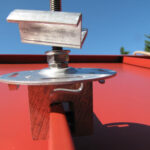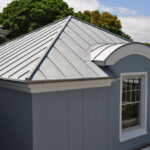Tie-Ins to Flat Roofs
ISSUE
In some cases, steep-pitched roofs tie in to a low pitched roof, either at the eave or at the peak of the roof.
SOLUTION
Whatever material is installed on the flat roof must be appropriate for that roof pitch. Under no circumstances should a metal roof ever be installed at a pitch lower than that recommended by the manufacturer (see Classic Products’ Technical Bulletin #2). When the flat roof is at the top of the metal roof, an appropriate flashing must be installed so that water drains off of the flat roof. Care must be taken to ensure that such water will not be contaminated with dirt or chemicals that might discolor the metal roof. If this might be a problem, consider installing a gutter to collect the water from the flat roof.
When the flat roof is at the bottom of the metal roof, there are several things to pay attention to. The underlayment beneath the metal roof must drain out on top of the flat roof. Ideally, the flat roof material should be brought up the steep roof portion by 1224” and the metal roof should be started at a level that covers only half of this amount. There should be a flashing installed beneath the starter on the metal roof that comes out on top of the flat roof. An extra piece of underlayment should be worked in that extends up under the rest of the underlayment on the steep roof and comes out on top of this flashing. The underlayment should not extend beyond the starter on the metal roof. This flashing should be designed in a way so that, if the flat roof is ever replaced, the flashing can be lifted up for the new flat roof to be installed. Using screws to fasten the metal roof in this area can facilitate removal and replacement of the metal roof if that is ever necessary in order to replace the flat roof.




